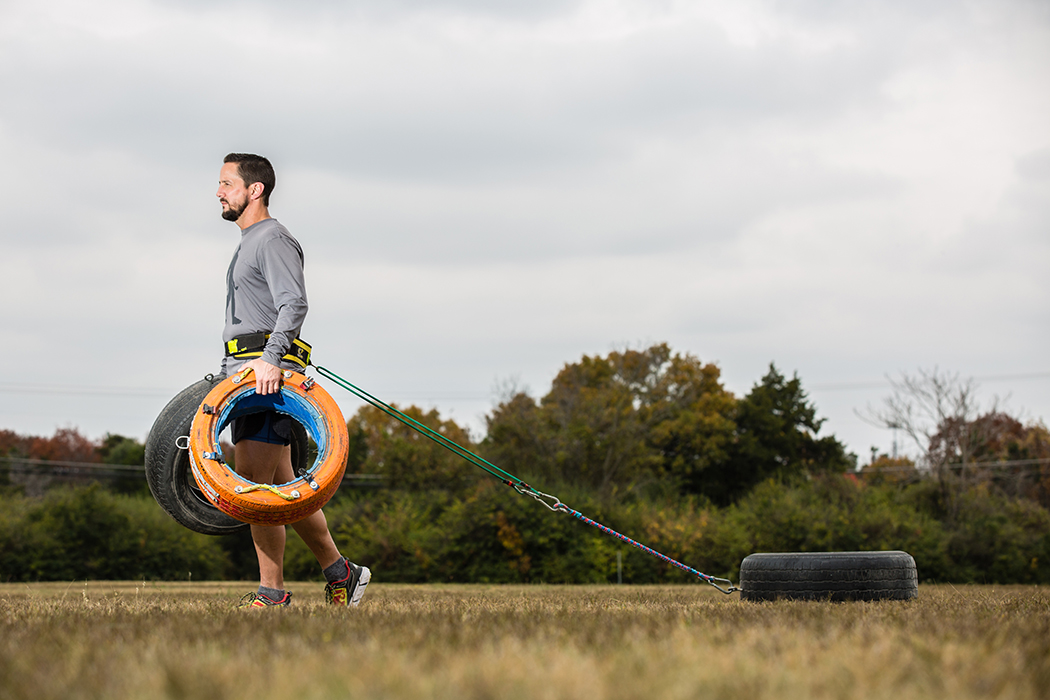
Monté completed the 314-mile Last Annual Vol-State race last year, and he hopes to one day take a stab at the mysterious Barclays Marathon. (Photos by Rasy Ran)
‘The crazier the better’
Steven Monté marches to the beat of his own drum, some might say. He enters competitions in which most sane folk desire no part. He runs, sometimes 100 miles in one stretch, up hills and through mud; he is known to do so with a 20-pound tire attached to his sinewy body. You might have seen him demonstrating this tire-pulling ritual around Lake Cliff Park. If so, you likely wondered, what the heck?
“I just got hooked on pulling a tire,” Monté says. “It forces so many mental issues upfront early in my workouts. I want to see how mentally strong I can get.”
Believe it or not, there are others like him.
Monté entered a 500-kilometer race last summer with Novle Rogers, a friend from East Dallas, who says his goal was to “have a hallucination — it’s something I’ve always wanted.”
To become so weary and sleep deprived from the run that one sees and hears non-existent things would be a small piece of the bigger physical, spiritual and mental experience, they say, of course.
Pain and exhaustion-induced visions are a common side effect of tackling the Last Annual Vol-State 500-kilometer race. The event lasts in excess of a week for most participants, beginning with a ferry ride across the Mississippi River, from Missouri to Kentucky, where the director, an eccentric Tennessean named Gary Cantrell, better known as Lazarus Lake, signals the start by lighting his cigarette.
Lazarus became famous last year with the release of a popular Netflix documentary “The Barclays Marathons,” about his crazy, secretive 100- (well, maybe 130-) mile footrace through the Cumberland Mountains of eastern Tennessee. To date, just 12 men, of 800 competitors since 1985, have completed The Barclays Marathons and mystery shrouds its registration process.
“There is no website, and I don’t publish the race date or explain how to enter,” Cantrell told the New York Times. “Anything that makes it more mentally stressful for the runners is good.”
That tells you a little bit about the mind behind the Last Annual Vol State Road Race (it’s not the last, this time, but someday it will be — thus the reasoning behind the tongue-in-cheek name).
Compared to Barclays, Cantrell’s 314-mile Last Annual Vol-State — “on foot, along highways and back roads, from one small town to the next, over hills and across rivers, up mountains and down long valleys, all the while accounting for all of their most basic needs such as food, water and sleep,” Laz notes — is the gentler endeavor.
Both Monté and Rogers are experienced ultrarunners who have tackled multiple 100-mile races through hills, extreme weather and mud (yes, sometimes pulling tires), but running 314 miles was a different beast, they say.
With each passing year, the Vol State race’s popularity increases, and residents of the towns along the course help out the unsupported runners.
“Every year they say more and more people are popping up to help,” Monté says. “They are called ‘road angels.’ ”
Still, the super long distance runners often are a strange sight, and aroma, to observers.
“We were resting outside a convenience store when a little kid asks his dad, ‘What’s that smell?’ and that gave us a good laugh,” Rogers recalls.
One runner, a woman prone to roadside naps, was called in as a dead body to police. “Twice,” Monté says with a chuckle.
Rogers completed the race in 177 hours, 32 minutes. Monté in about 204.
“Vol State taught me that there is a way to break anything down, make it doable,” says Monté, who recently ran a 100-mile race with his tire in tow.
So is the famous Barclays Marathon next?
Just to get accepted into that field could take three to five years, Monté guesses, especially now that the movie is out.
“I hope so, because I need the time to prepare,” he says, adding that everything he does now is in preparation for someday attempting Barclays.
“The lure of this race is there’s a certain subculture of trail running that is pure, do-it-for-the-fun type deal and you see a lot of those people at [Gary Cantrell’s races],” Monté says. “The oldest finisher [at Vol State] was a 75-year-old race veteran … he was clipped by a car a few days into the race but finished anyway.”
None of it makes much sense when you try to explain it.
Maybe it’s just knowing that “anything can happen in any given race,” as Monté says, and the longer and more extreme the race, the broader the scope of possibilities. “The crazier the better.”




